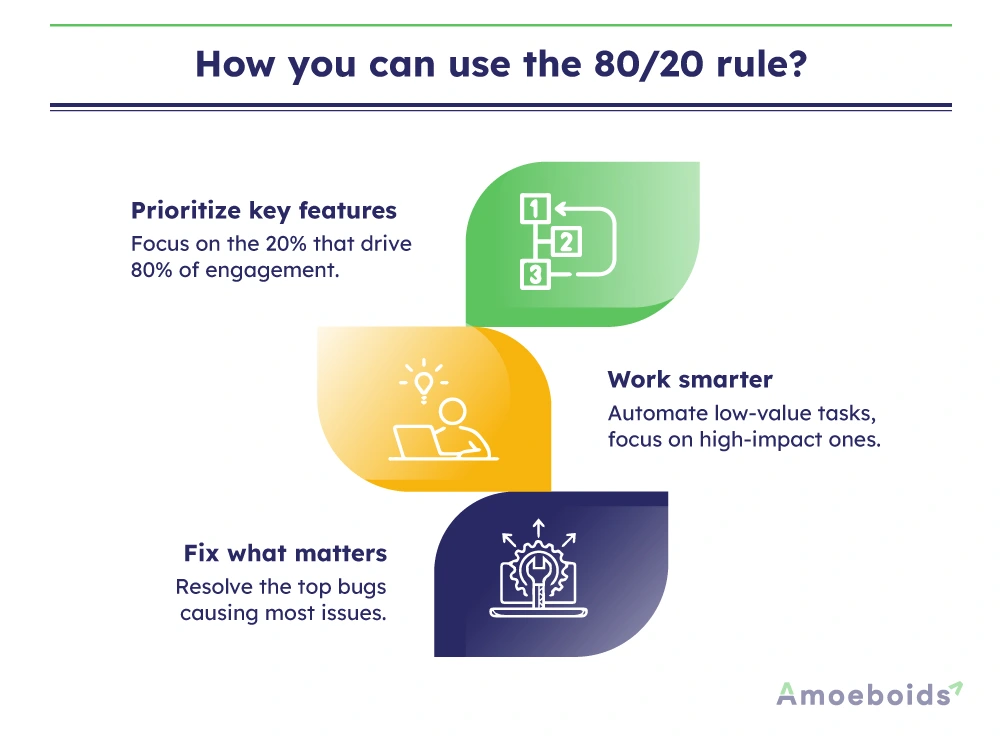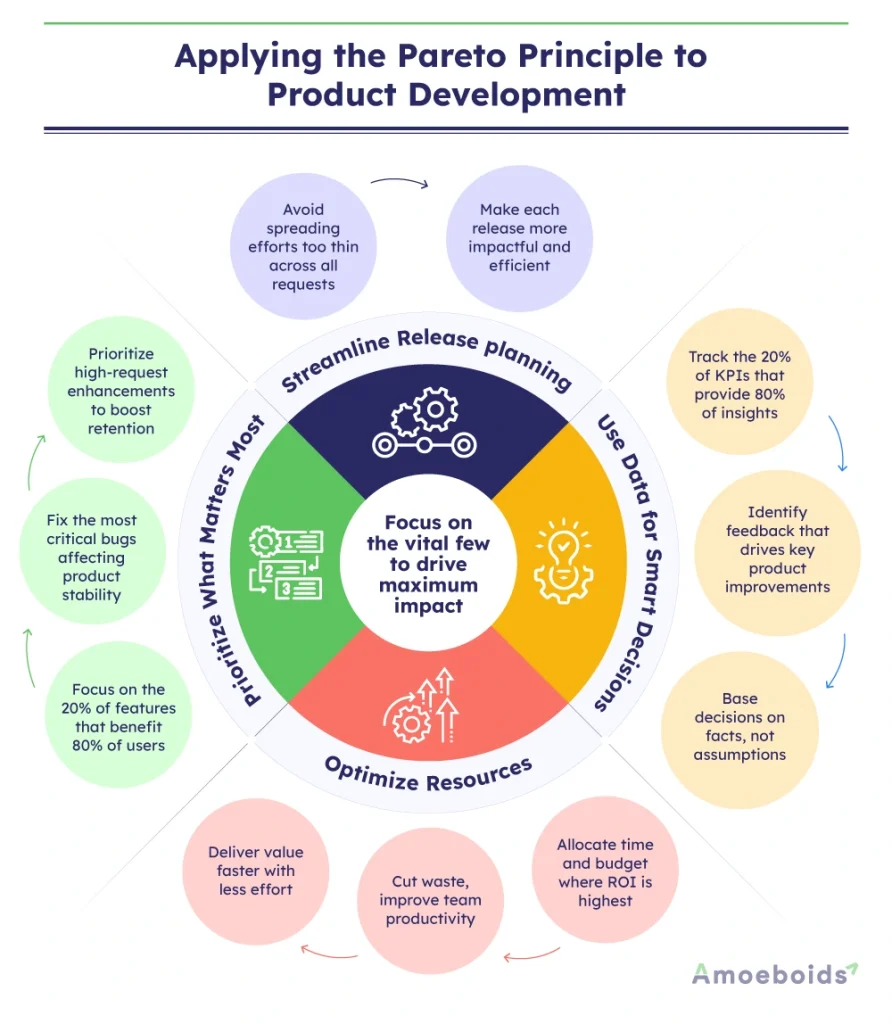If you’ve ever spent hours working on something only to realize that just a small part of your effort made a real difference, you’ve already experienced the Pareto Principle in action. Also known as the Pareto rule or the 80/20 rule, it suggests that 80% of outcomes often come from just 20% of efforts. While it’s not a strict mathematical law, the pattern appears in everything from business revenue to software development, where a handful of critical issues can lead to the majority of user complaints.
Understanding the Pareto rule can be transformative for product managers, release managers and software teams. Instead of spreading resources too thin, you can focus on high-impact tasks that drive the most value – whether that’s prioritizing feature development, streamlining release management, or addressing the most significant customer pain points.
But how does the Pareto 20-80 concept work in practice, and how can you apply it to product development? Let’s look into it in further detail.
What is the Pareto Principle?
The Pareto Principle describes an uneven distribution of cause and effect – meaning that a small portion of input often leads to a disproportionate share of results.
The Paretian distribution, a statistical concept, helps explain this pattern. It shows that in many real-world scenarios, data isn’t evenly spread. Instead, a small set of contributing factors account for most of the impact. It was first identified by Vilfredo Pareto, an Italian economist, who noticed that 80% of Italy’s land was owned by just 20% of its population.
Since then, it has been applied across fields like business, technology and operations.
In software development, for example, 20% of system bugs often cause 80% of software failures. Similarly, 20% of features in an application may drive 80% of customer engagement. Recognizing these imbalances allows you to focus on the highest-value areas, leading to more efficient decision-making.
Recognizing this pattern can help your business and team work more efficiently by identifying which features, issues, or strategies deserve the most attention.
How you can use the 80/20 rule
Applying the Pareto rule is about finding and focusing on the most valuable efforts. Whether you’re managing a product, optimizing your workflow or improving customer experience, recognizing what truly moves the needle can help you achieve better results with fewer resources.
Here are a few ways you can put the Pareto Principle into action for your team.

Prioritizing product features that truly matter
Not all features are equally valuable to users. Some may be overused by a majority of customers, while others remain underutilized. A deep analysis of user behavior often reveals that 20% of features drive 80% of engagement, proving the Pareto rule. Instead of trying to build everything, product teams can concentrate on high-value functionality that improves retention and user satisfaction.
Amoeboids’ Roadmap and Idea Portal App can help your team collect and prioritize feature requests based on actual customer feedback. Customers can vote for features directly through the app, allowing you to identify the most requested ones and ensure your development resources have the greatest impact.
Boosting productivity through smarter task management
Time management follows the Pareto Principle as well. If you look closely, you will find that a handful of your daily tasks generate most of your meaningful output, while other activities only consume time without adding much value. Once you separate the meaningful tasks from the ones that are time and resource-consuming, you can shift priorities and improve the project’s progress and revenue.
For example, as a release manager handling multiple projects at once, you might find that a small number of tasks – like finalizing major feature updates and coordinating developer feedback – drive the majority of the release’s success. By automating non-essential tasks like documenting release notes, you can free up your team’s time for more critical activities.
Amoeboids’ Automated Release Notes & Reports App is designed to remove the burden of manually compiling release notes, allowing you to focus on the work that matters most.
Fixing critical software bugs first
Not all bugs are equally disruptive. Some may be minor glitches, while others significantly impact user experience. Research suggests that a small number of defects – often around 20% – are responsible for the majority of system crashes, performance issues and customer complaints.
Addressing these high-impact issues first can lead to significant product improvements with minimal effort. Instead of spreading development resources thin across low-priority fixes, focusing on the most pressing problems first ensures that users experience immediate improvements in functionality and stability.
Benefits of using the Pareto Principle
The 80/20 rule isn’t just about prioritizing better – it’s about working smarter. A recent study even suggests that many employees waste more than eight hours per week on unproductive tasks that are not crucial to revenue. The Pareto rule can help you maximize productivity by focusing on meaningful tasks.
As a product manager, you will see the following impacts when you implement the Pareto Principle for yourself and your team:
- Increased efficiency – Identifying high-impact work means fewer wasted resources
- Stronger decision-making – Focusing on what truly matters leads to better business outcomes
- Higher product quality – Resolving the most disruptive issues improves overall user satisfaction
- Optimized resource allocation – Development efforts go toward features and fixes that bring the most value
By consistently applying the Pareto Principle, you can accelerate your progress while minimizing your effort. However, there are certain cautionary factors to keep in mind.
Disadvantages of using the 80/20 rule
Despite its benefits, the Pareto Principle isn’t always a perfect model. There are situations where it may not apply, or where over-reliance on the rule can create blind spots.
One major challenge is that not everything follows an 80/20 distribution. In some cases, the ratio may be closer to 70/30 or even 90/10. Additionally, over-focusing on the top 20% can lead to neglecting long-term innovations that don’t offer immediate returns.
It’s also important to recognize that not all problems can be solved simply by prioritizing the “biggest” ones. Some smaller issues, when left unattended, can compound into much larger, flow-stopping issues over time.
To use the Pareto Principle effectively, teams must balance short-term impact with long-term strategy.
How does the Pareto Principle apply to product development?
Applying the Pareto rule in your software development and product management workflows can help you make smarter decisions about what to build, fix, or improve first or next. It can help you prioritize your tasks to maximize efficiency in your workflow.
Here are some benefits you can look forward to.

Streamlining release planning and execution
Every product team faces the challenge of deciding which updates and fixes to prioritize in a release cycle. Instead of treating all feature requests and bug reports equally, you can apply the Pareto Principle to focus on:
- The 20% of product updates that will benefit 80% of users
- The most critical bug fixes that significantly impact product stability
- The most frequently requested enhancements that drive long-term user retention
When you identify and track the most important updates and fixes, you can ensure that each release is impactful and all your team’s efforts are going into something that truly drives results.
Using data-driven insights for better decision-making
Product managers often rely on analytics to understand what’s working and what’s not. By tracking key performance indicators (KPIs) and customer feedback, you can identify the 20% of product metrics that provide the majority of useful insights. This allows you to:
- Ensure efficient resource allocation, maximizing ROI and improving efficiency
- Make informed decisions based on empirical evidence
- Optimize resource allocation, reduce waste and enhance productivity
Data-driven insights will help you prioritize efforts on the most impactful factors, reduce costs and increase objectivity. Next, we’ll learn how to put these principles into action.
Pareto Principle examples
You’ve probably noticed that not all tasks, customers or issues are equally important. Some have way more impact than others – and that’s exactly what the Pareto Principle highlights. By recognizing which 20% of factors drive 80% of results, you can prioritize better, save time and get bigger wins with less effort. Here’s how this plays out in real-world scenarios.
Software development: Identifying high-impact bug fixes
Ever feel like you’re constantly chasing down issues but never making real progress? That’s because not all bugs deserve equal attention. If you analyze error reports, you’ll likely find that a small percentage of critical bugs cause a majority of crashes and user complaints.
For example, imagine your team is working on a major product update. You could spend weeks fixing every minor UI glitch – or you could identify the 20% of bugs that are responsible for most crashes and frustrations. Teams that focus on fixing these high-impact issues first see immediate improvements in product stability, customer satisfaction and retention – without getting stuck in endless troubleshooting.
It’s not just about bugs, either. If you analyze feature usage, you’ll often find that most engagement (80%) comes from just a few core functionalities (20%). Instead of spreading your development efforts thin, you can double down on refining and expanding the features that matter most to your users.
Business revenue: Nurturing the most value-driving customers
If you dig into your sales data, you’ll often see that a small percentage of high-value customers account for most of your revenue, while the majority contribute far less.
Take enterprise software sales as an example. While you may have hundreds of smaller clients, just a handful of large contracts could be generating 80% of your total revenue. That’s why sales and customer success teams focus on nurturing and retaining these high-value clients, ensuring they get dedicated support, exclusive features and priority service – because losing just one of them could have a much bigger impact than losing dozens of smaller customers.
At the same time, not all leads are worth chasing. Instead of spending resources equally across all leads, teams that focus on the most promising ones close more deals while using less effort.
Customer support: Fixing the smaller issues that bring bigger tickets
If you’re managing customer support, you know how overwhelming it can get when tickets pile up. But when you step back and analyze the data, you’ll often see that the majority of support tickets (80%) come from just a handful of recurring issues (20%).
Apply the Pareto Principle. Instead of trying to tackle every issue individually, analyze the top pain points and create automated fixes to solve repeated issues. This way, your team can spend time on higher-value support tasks instead.
The wide range of scenarios where the Pareto rule applies makes it an essential practice for professionals and executives of all levels from all industries.
Work smarter with the Pareto Principle
The Pareto 20/80 rule helps you prioritize what truly matters, ensuring your team focuses on high-impact tasks instead of getting lost in the details. It allows you to work more efficiently and improve outcomes by working smarter, not harder.
That said, not everything fits neatly into the 80/20 rule. Some tasks – like security updates or compliance checks – need attention regardless of their impact. The key is knowing when and where to apply it.
For product teams, the Pareto Principle is invaluable for feature development, bug fixes and customer support. Instead of trying to chase every issue that crops up, you can prioritize the work that really moves the needle.
Want to optimize your workflow and automate low-value tasks? Explore Amoeboids’ suite of apps and start making smarter product decisions today.
FAQs
How true is the Pareto Principle?
The Pareto Principle is an observed trend, not a strict rule. While the exact 80/20 split varies, the pattern is widely seen across industries.
Is the Pareto Principle scientific?
The Pareto Principle is not considered a scientific law. It is an observation based on patterns seen in various situations supported by empirical data. However, it’s more of a heuristic than a mathematical law.
Who created the Pareto Principle?
Italian economist Vilfredo Pareto first discovered the concept in 1896 while studying wealth distribution across Italy and it has been named after him. He summarized the rule by observing and collating statistical data and economic factors.
What is the Pareto Principle used for?
The 80/20 rule is used for product development, time management, sales, marketing and decision-making. It’s a useful tool for prioritizing tasks, improving performance, and making better decisions.
Are there exceptions to the Pareto Principle?
Yes, not all scenarios follow a typical Pareto 20-80 split. Some cases might be 70/30 or 90/10, so the Pareto rule should be used as a general guideline.



